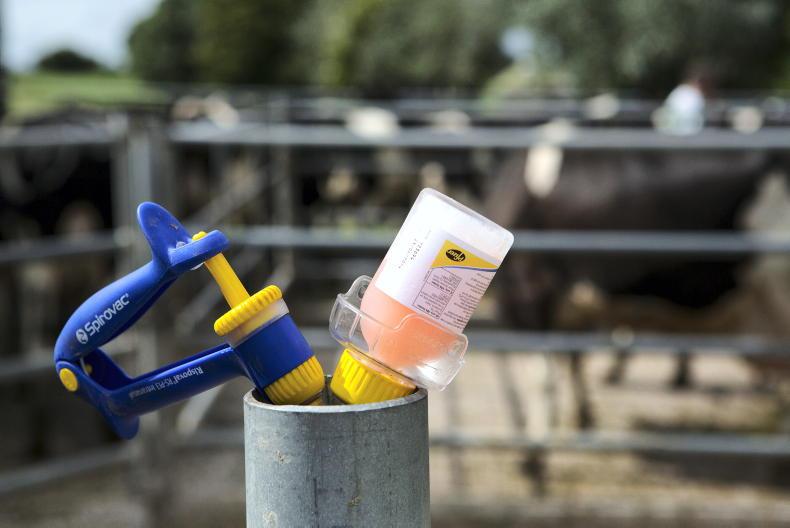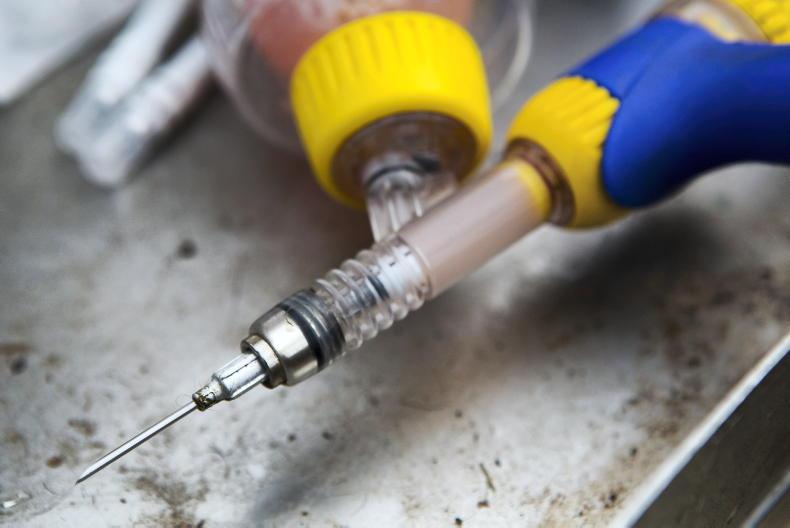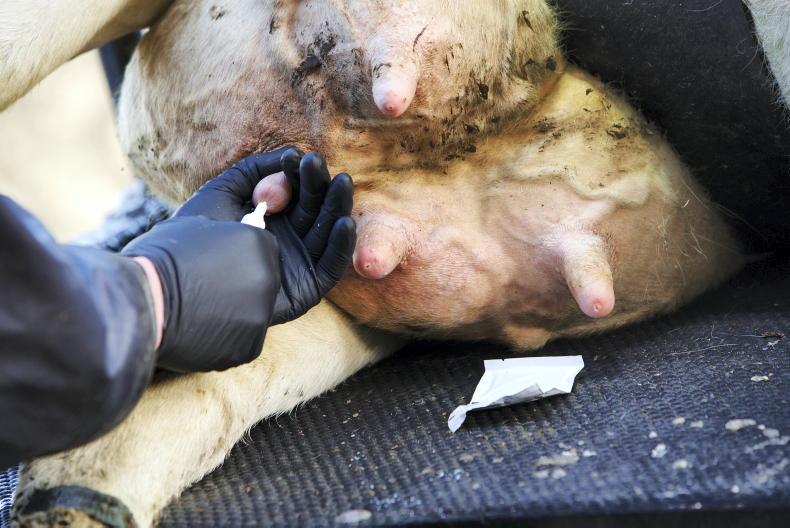Prior to 2022, it was common practice to treat all quarters of cows with an antibiotic tube at drying-off. This was known as a blanket dry-cow strategy. However, a new veterinary medicine regulation (EU regulation 2019/6) is now in place, requiring a different approach to the prescribing of veterinary medicines.
The overall aim of this new legislation is to protect public (and animal) health into the future, by reducing the speed at which antimicrobial resistance (AMR) develops.
The same antibiotics are often used for both humans and animals. No new antibiotics have been developed for over 30 years, highlighting the need to protect the antibiotics we currently have to ensure they continue to work.
AMR occurs when an antibiotic that was previously effective in treating an infection no longer works. The new legislation will help to ensure antibiotics are used more carefully and only used when necessary.
Blanket dry cow therapy has been replaced with individually assessing and treating selected cows with dry cow antibiotic therapy, known as selective dry cow therapy (SDCT).
How are cows individually
assessed?
Your vet, who should have a detailed and thorough understanding of your farm, herd, records, facilities and management, will prescribe dry cow tubes for cows that are at risk of, or have, mastitis at drying off.
Your vet assesses mastitis risk based on both your herd and cow level information.
What herd level information is helpful?
Herd information consists of records of clinical cases and levels of infection during the previous 12 months and ideally includes levels of;
Recent infections during lactation.Persistent infections during lactation.New dry period infections within 60 days of calving. Cure rates over the last dry period.If you are milk recording, your CellCheck Farm Summary report gives this information summarised as star ratings and actual figures.
If you are not milk recording, the available herd-level information is much more limited, making implementation of SDCT more challenging, but may include records of clinical mastitis and tube usage for each cow on a date basis and the monthly bulk tank SCC over the previous 12 months.
What cow level information
is helpful?
This includes any electronic (farm software app or ICBF) or paper records that you have for cow events such as cases of mastitis, treatments, culture results or changes in milk production, which should be examined with your veterinary practitioner.
Following the assessment for each cow, your vet can prescribe antibiotics for the cows where this is considered prudent, with others receiving teat sealer only.
If insufficient information is available to assist in prudent prescribing or if milk recording has not been carried out throughout the lactation, the alternatives to provide cow level information are a single milk recording from each cow four to six weeks before drying off, individual milk culture results or California Mastitis Testing at drying off.
The CellCheck Technical Working Group has developed a document titled The Selective Dry Cow Strategy 2022, which gives guidance on future mastitis control decisions for your farm.
The key points of the strategy are as follows:
The review, development and agreement of a standard operating protocol on mastitis treatments with your vet. If you are not milk recording, it is important to commence recording as soon as possible to monitor mastitis control in your herd throughout the entire lactation and also to ensure that sufficient information is available when it comes to drying off next year.In herds at higher mastitis risk, such as those with a bulk milk SCC above 200,000 cells/ml at any point during the lactation, selective dry-cow therapy is more challenging. In these herds, the risk of continued or new infections over the dry period is higher, and it can be difficult to accurately distinguish infected and non-infected cows at the time of drying-off. If you have a higher risk herd, a more detailed investigation is necessary to examine all the risk factors relating to mastitis. This will allow you to develop and agree a plan with your vet and other service providers including milk quality advisers, milking machine technicians and other advisers to address these risks and ensure more effective mastitis control.
A selective dry-cow strategy is not without risk, hence the importance of a detailed review of all farm and individual animal-level information by your prescribing veterinary practitioner.
However, many Irish farms have been doing SDCT successfully for a number of years, by carefully selecting suitable cows, ensuring excellent hygiene at drying off and during the housing period and not rushing the job.
A free Dry Cow Consult is available again this year for eligible herds. This three-hour consultation is carried out with your vet and is an opportunity to assess the current drying off process and dry period performance and identify additional gains that can be made.
Milk recording results and farm records will also be analysed to identify individual animals that are suitable for teat seal only, and the best way of implementing this.
Animal health tips October
Parasites: Housing of animals provides an opportunity to review any parasite control plan that you have in place with your veterinary practitioner. Different groups of animals may still have internal parasites - gut worms, fluke, lungworm (hoose) or external parasites such as lice or mange that may affect growth rates or milk yield. Dung samples from different groups of animals will tell you which types of parasites are present. Treatments are varied, so discuss with your vet. Vaccination: Salmonella in pregnant cows or heifers can spread at this time of year due to the presence of, or buying in of carrier animals. Salmonella vaccination is important to prevent both systemic disease and abortion. Measures for the prevention of weanling pneumonia, in particular IBR, should be reviewed. Stress, latent infection, transport and intermixing of animals at this time of year predisposes youngstock to viral pneumonia and implementing a vaccination plan should be discussed with your vet. Hygiene: Many infections are picked up by animals during housing, including mastitis, pneumonia or lice, if space is lacking or the animals are in a dirty or poorly ventilated environment, so it is important to review housing in advance to determine if maintenance or upgrading is needed.
Prior to 2022, it was common practice to treat all quarters of cows with an antibiotic tube at drying-off. This was known as a blanket dry-cow strategy. However, a new veterinary medicine regulation (EU regulation 2019/6) is now in place, requiring a different approach to the prescribing of veterinary medicines.
The overall aim of this new legislation is to protect public (and animal) health into the future, by reducing the speed at which antimicrobial resistance (AMR) develops.
The same antibiotics are often used for both humans and animals. No new antibiotics have been developed for over 30 years, highlighting the need to protect the antibiotics we currently have to ensure they continue to work.
AMR occurs when an antibiotic that was previously effective in treating an infection no longer works. The new legislation will help to ensure antibiotics are used more carefully and only used when necessary.
Blanket dry cow therapy has been replaced with individually assessing and treating selected cows with dry cow antibiotic therapy, known as selective dry cow therapy (SDCT).
How are cows individually
assessed?
Your vet, who should have a detailed and thorough understanding of your farm, herd, records, facilities and management, will prescribe dry cow tubes for cows that are at risk of, or have, mastitis at drying off.
Your vet assesses mastitis risk based on both your herd and cow level information.
What herd level information is helpful?
Herd information consists of records of clinical cases and levels of infection during the previous 12 months and ideally includes levels of;
Recent infections during lactation.Persistent infections during lactation.New dry period infections within 60 days of calving. Cure rates over the last dry period.If you are milk recording, your CellCheck Farm Summary report gives this information summarised as star ratings and actual figures.
If you are not milk recording, the available herd-level information is much more limited, making implementation of SDCT more challenging, but may include records of clinical mastitis and tube usage for each cow on a date basis and the monthly bulk tank SCC over the previous 12 months.
What cow level information
is helpful?
This includes any electronic (farm software app or ICBF) or paper records that you have for cow events such as cases of mastitis, treatments, culture results or changes in milk production, which should be examined with your veterinary practitioner.
Following the assessment for each cow, your vet can prescribe antibiotics for the cows where this is considered prudent, with others receiving teat sealer only.
If insufficient information is available to assist in prudent prescribing or if milk recording has not been carried out throughout the lactation, the alternatives to provide cow level information are a single milk recording from each cow four to six weeks before drying off, individual milk culture results or California Mastitis Testing at drying off.
The CellCheck Technical Working Group has developed a document titled The Selective Dry Cow Strategy 2022, which gives guidance on future mastitis control decisions for your farm.
The key points of the strategy are as follows:
The review, development and agreement of a standard operating protocol on mastitis treatments with your vet. If you are not milk recording, it is important to commence recording as soon as possible to monitor mastitis control in your herd throughout the entire lactation and also to ensure that sufficient information is available when it comes to drying off next year.In herds at higher mastitis risk, such as those with a bulk milk SCC above 200,000 cells/ml at any point during the lactation, selective dry-cow therapy is more challenging. In these herds, the risk of continued or new infections over the dry period is higher, and it can be difficult to accurately distinguish infected and non-infected cows at the time of drying-off. If you have a higher risk herd, a more detailed investigation is necessary to examine all the risk factors relating to mastitis. This will allow you to develop and agree a plan with your vet and other service providers including milk quality advisers, milking machine technicians and other advisers to address these risks and ensure more effective mastitis control.
A selective dry-cow strategy is not without risk, hence the importance of a detailed review of all farm and individual animal-level information by your prescribing veterinary practitioner.
However, many Irish farms have been doing SDCT successfully for a number of years, by carefully selecting suitable cows, ensuring excellent hygiene at drying off and during the housing period and not rushing the job.
A free Dry Cow Consult is available again this year for eligible herds. This three-hour consultation is carried out with your vet and is an opportunity to assess the current drying off process and dry period performance and identify additional gains that can be made.
Milk recording results and farm records will also be analysed to identify individual animals that are suitable for teat seal only, and the best way of implementing this.
Animal health tips October
Parasites: Housing of animals provides an opportunity to review any parasite control plan that you have in place with your veterinary practitioner. Different groups of animals may still have internal parasites - gut worms, fluke, lungworm (hoose) or external parasites such as lice or mange that may affect growth rates or milk yield. Dung samples from different groups of animals will tell you which types of parasites are present. Treatments are varied, so discuss with your vet. Vaccination: Salmonella in pregnant cows or heifers can spread at this time of year due to the presence of, or buying in of carrier animals. Salmonella vaccination is important to prevent both systemic disease and abortion. Measures for the prevention of weanling pneumonia, in particular IBR, should be reviewed. Stress, latent infection, transport and intermixing of animals at this time of year predisposes youngstock to viral pneumonia and implementing a vaccination plan should be discussed with your vet. Hygiene: Many infections are picked up by animals during housing, including mastitis, pneumonia or lice, if space is lacking or the animals are in a dirty or poorly ventilated environment, so it is important to review housing in advance to determine if maintenance or upgrading is needed. 








SHARING OPTIONS